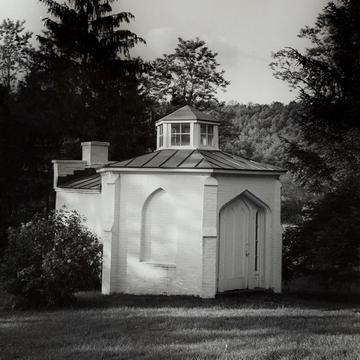This engaging little hexagonal brick building (approximately 17 feet in diameter) with Gothic Revival detailing has the air of a folly about it, which belies entirely the purpose for which it was built and the seriousness of the endeavors that took place within. It stands near the road, toward the western end of the mansion's front yard, and has always been painted, first a straw color, and currently white. Louis Hobbs, who designed and built the original Bethany College building that burned in 1857, is credited with the design. A hexagonal skylight on the apex of the shallow pyramidal roof—its form mimicking the shape of the study—helps provide light.
A later, square addition, also of brick and housing a fireplace in an alcove, stands to the rear, opposite the front door. A jib, or triplehung, window in its east wall faces the house. Four bookcases with sliding glass fronts reach to the ceiling on four sides. Here Campbell wrote many of his sixty published works and edited manuscripts for the Millennial Harbinger, a church periodical.
Members of the Disciples of Christ Church have long regarded their founder's study as a shrine. A replica (of unpainted red brick), protected by an open, hexagonal, stone arcade designed by John Russell Pope, stands adjacent to his National City Christian Church on Thomas Circle in Washington, D.C.














